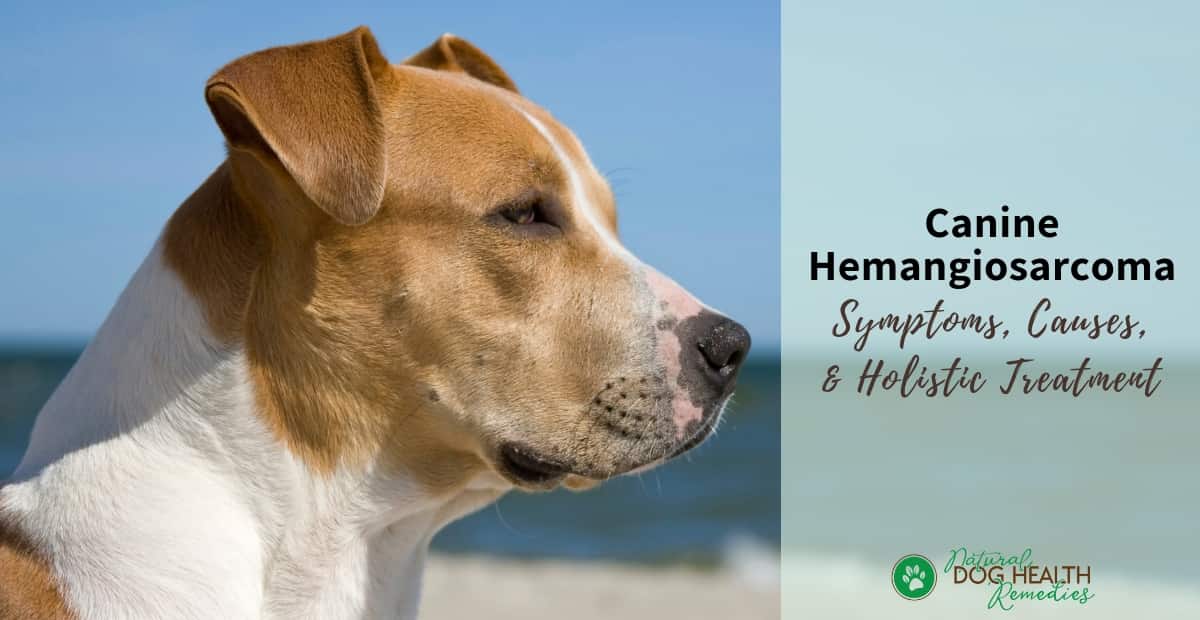Canine Hemangiosarcoma

What is Hemangiosarcoma?
A sarcoma refers to a cancer that arises from cancerous cells developed out of certain tissues, such as bone or muscle. Hemangiosarcoma is a type of cancer that arises out of the soft supporting tissues that surround blood vessels.
Canine hemangiosarcoma mostly affects the dog's spleen, heart, liver, subcutaneous tissue, and skin.
Hemangiosarcoma in dogs accounts for about 5 to 7% of all malignant cancers. The cancerous cells spread very rapidly and, along their way, they build their own blood vessel network which disrupts the normal functioning of the affected organs in the dog patient.
Types and Symptoms of Canine Hemangiosarcoma
There are three types of hemangiosarcoma in dogs:
Dermal (skin)Hemangiosarcoma of the skin appears as a dark, raised skin lesion, usually on areas without hair, such as the abdomen.
Dogs with short or less hair (e.g. Dalmatians, Whippets, Basset Hounds) have a higher risk of developing this type of hemangiosarcoma.
Hypodermal (under the skin)This type of hemangiosarcoma can arise in all parts of the dog's body, under the skin. The tumor may be soft, or it can be a firm mass with ulceration.
Visceral (splenic or cardiac)Visceral hemangiosarcoma most commonly occurs in the dog's spleen and the right atrium of the heart. The characteristics of this type of hemangiosarcoma is that it is locally invasive and prone to spread to other locations.
Many of the warning signs of visceral hemangiosarcoma are non-specific, and are dependent on the actual location of the tumor.
For example, the dog may have:
- Signs of lethargy and weakness
- Lameness
- Appetite loss
- Weight loss
- Bleeding, especially nosebleeding
- Pale gums (due to anemia)
- An enlarged swollen abdomen (when hemangiosarcoma occurs in the spleen, the tumor sometimes can get very large)
- Exercise intolerance and short of breath (when hemangiosarcoma occurs in the heart)
More specific signs may be collapse or seizure caused by shock resulting from rupture of the affected organ.
Who are Affected?
Hemangiosarcoma affects mostly middle-aged to older larger breeds of dogs. The average age of affected dog is eight to ten years.
For some reason, male dogs are more susceptible to this form of cancer than female dogs.
Breed-wise, German shepherds have the highest chance of developing hemangiosarcoma, especially the visceral form of this cancer. Other high-risk breeds include golden retrievers, Labrador retrievers, boxers, poodles, schnauzers, pointers, dalmatians, and Doberman pinchers.
Causes and Diagnosis
The exact cause of hemangiosarcoma in dogs is unknown, although it is believed that genetic factors play an important part due to the presence of this cancer in certain breeds of dogs.
Sun exposure may be a risk factor to the development of the dermal form of hemangiosarcoma.
Early diagnosis is made with regular X-rays or ultrasound examination of the chest and abdomen.
If hemangiosacroma is suspected, further blood tests are made. Abdominal fluid is aspirated to check for the presence of blood due to internal bleeding. Biopsy may also be done for a proper diagnosis.
Stages of Canine Hemangiosarcoma
Splenic hemangiosarcoma is categorized into three stages:
- Stage I: The tumor is confined to the spleen and hasn't spread to other areas.
- Stage II: The tumor has ruptured, with or without metastasis to regional lymph nodes.
- Stage III: Cancer has metastasized to lymph nodes or other parts of the body.
Treatment for Canine Hemangiosarcoma
 Treatment for hemangiosarcoma depends on the type and location of the tumor.
Treatment for hemangiosarcoma depends on the type and location of the tumor.
Hemangiosarcoma that arises on the skin (dermal) may be removed surgically if it is small and confined only to the surface of the skin.
For treatment of hemangiosarcoma that occurs in the spleen, the heart atrium, or under the skin, it may be possible to surgically remove the primary tumor, which usually provides dramatic results.
However, before surgery is even considered, an ultrasound examination should be done to see if there are lesions in the organs of the chest and abdomen, in order to determine a prognosis.
Post-surgery chemotherapy may be needed for hemangiosarcoma in the liver, spleen, under the skin and in the bone, in order to extend the dog patient's life quality for nine to 18 months.
I'm-Yunity for Canine Hemangiosarcoma
"I'm Yunity" is a supplement made from Yunshi mushroom (Coriolus versicolor) extract. According to a study done by University of Pennsylvania School of Veterinary Medicine, the supplement is surprisingly effective in fighting hemangiosarcoma in dogs, with no adverse effects.
A researcher in the study reported that they had had dogs that lived beyond a year with nothing other than this mushroom supplement as treatment. The supplement is not inexpensive, but it is definitely worth a try to save our furkids.
Survival Time of Dogs with Hemangiosarcoma
Survival time depends on the location of the tumor and whether it has spread or not.
For example, a dog with a small, superficial skin tumor that has not spread could be cured by surgical removal of the tumor.
On the other hand, dogs with spleen hemangiosarcoma can rarely be cured even after surgery. The average survival time is about 2 months post-surgery, with only 10 percent survival at one year. If a dog is treated with both surgery and chemotherapy, the survival time is from 6 to 8 months.

Natural Remedies May Help
University of Pennsylvania School of Veterinary Medicine
NC State Veterinary Hospital, Canine Hemangiosarcoma
S. Messonnier, The Natural Vet's Guide to Preventing and Treating Cancer in Dogs (New World Library, 2006).





